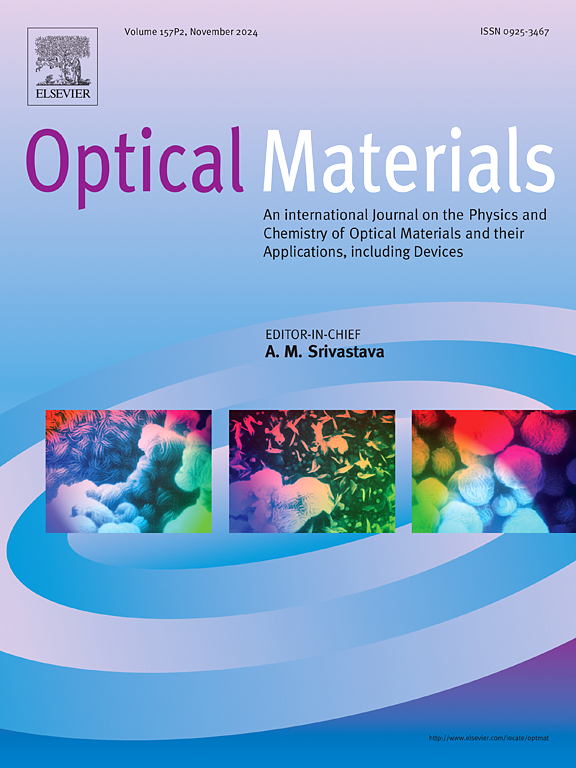低浓度钒和钛离子对硼磷酸盐玻璃结构和光学性能的影响
IF 4.2
3区 材料科学
Q2 MATERIALS SCIENCE, MULTIDISCIPLINARY
引用次数: 0
摘要
采用熔淬法制备了V2O5和TiO2含量(0.25 ~ 0.75 mol%)不同的P2O5-B2O3-BaO玻璃体系,考察了其结构、EPR和光学特性。EPR分析证实了VO2+的超细分裂和Ti3+离子在四方压缩八面体结构中的存在。通过自旋哈密顿参数(g∥<g⊥<ge)和光跃迁能探索了VO2+和Ti3+中心的局部结构。紫外可见光谱显示钒(V3+、VO2+和V5+)和钛(Ti3+、Ti4+)存在多种氧化态,对其光学特性有显著影响。光致发光(PL)研究表明,在玻璃基体中存在氧空位和固有缺陷,[VO4]3-基团和Ti3+离子显著增强了发射性能。当TiO2和V2O5浓度分别为0.75 mol%和0.75 mol%时,玻璃的发光增强。值得注意的是,掺0.75 mol% v2o5的玻璃呈现出CIE色度坐标(x = 0.26, y = 0.31),与标准白光紧密对齐。通过过渡金属氧化物掺杂的光学特性的可调性突出了这些玻璃在先进光子应用方面的潜力,包括光学滤光片和显示技术。本文章由计算机程序翻译,如有差异,请以英文原文为准。

Influence of low concentrations of vanadium and titanium ions on the structural and optical properties of borophosphate glasses
A series of P2O5–B2O3–BaO glass system containing various V2O5 and TiO2 content (from 0.25 to 0.75 mol%) were synthesized using the melt-quenching method to examine their structural, EPR, and optical characteristics. EPR analysis confirmed VO2+ hyperfine splitting and the presence of Ti3+ ions in a tetragonally compressed octahedral structure. The local structures of VO2+ and Ti3+ centers were explored through spin Hamiltonian parameters () and optical transition energies. UV–visible spectroscopy revealed multiple oxidation states of vanadium (V3+, VO2+ and V5+) and titanium (Ti3+, Ti4+), which significantly influenced the optical characteristics. Photoluminescence (PL) studies indicated the presence of oxygen vacancies and intrinsic defects in the glass matrix, with [VO4]3- groups and Ti3+ ions significantly enhancing emission properties. The enhanced luminescence was observed for glasses with 0.75 mol% TiO2 and 0.75 mol% V2O5. Notably, the 0.75 mol% V2O5-doped glass, exhibited CIE chromaticity coordinates (x = 0.26, y = 0.31), closely aligning with standard white light. The tunability of optical properties through transition metal oxide doping highlights the potential of these glasses for advanced photonic applications, including optical filters and display technologies.
求助全文
通过发布文献求助,成功后即可免费获取论文全文。
去求助
来源期刊

Optical Materials
工程技术-材料科学:综合
CiteScore
6.60
自引率
12.80%
发文量
1265
审稿时长
38 days
期刊介绍:
Optical Materials has an open access mirror journal Optical Materials: X, sharing the same aims and scope, editorial team, submission system and rigorous peer review.
The purpose of Optical Materials is to provide a means of communication and technology transfer between researchers who are interested in materials for potential device applications. The journal publishes original papers and review articles on the design, synthesis, characterisation and applications of optical materials.
OPTICAL MATERIALS focuses on:
• Optical Properties of Material Systems;
• The Materials Aspects of Optical Phenomena;
• The Materials Aspects of Devices and Applications.
Authors can submit separate research elements describing their data to Data in Brief and methods to Methods X.
 求助内容:
求助内容: 应助结果提醒方式:
应助结果提醒方式:


